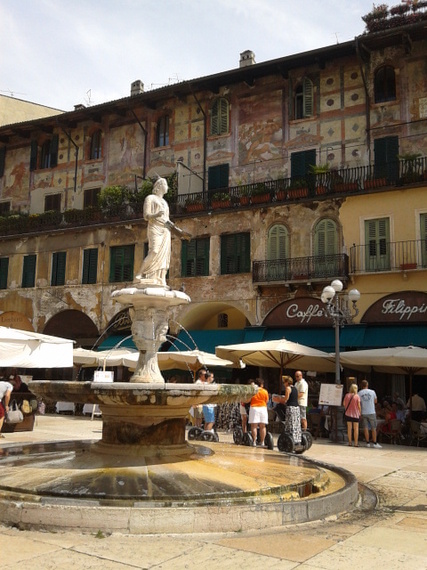Today I was passing by Verona, the city of Juliet and Romeo, the Roman arena hosting international opera and lyrical performances and hometown of Latin love poet Catullus. When entering the city, a big brown plaque informed me of the city being awarded the World Heritage Site status by UNESCO because of its urban structure and architecture.
As of 2014, there are a total of 1,007 World Heritage sites located in 161 states parties. Of the 1,007 sites, 779 are cultural, 197 are natural and 31 are mixed properties (UNESCO data). The countries with major concentration of world heritage site are Italy ( 50 sites), followed by China ( 47), Spain (44), Germany (39), France (39), Mexico (32), India (32), UK (28), Russia (26), USA (22), Australia (19) and Brazil (19).
In terms of worldwide investments in culture though, the national ministries of cultures are not doing enough to show the wonders of their places and are not putting enough efforts to gather sufficient fundings and resources to sustainably use it in cultural restorations, research and innovation to protect nature, monuments and cultural heritage.
The UNESCO convention for the protection of the world cultural and natural heritage (1972) contains two main points: one on nature conservation and the other on the preservation of cultural properties, recognizing the way in which people interact with nature, and the fundamental need to preserve the balance between the two. Strengthening the relationship between people, their ecosystems and their natural heritage, putting people at the center of sustainable development are also highlighted in the outcome document of the UN's Rio +20 conference, the Future We want (2012). Embracing this holistic approach, both biodiversity and cultural diversity are equally important as 4th pillar of development, along with the economic, environmental and social pillars.
The other day, a friend of mine, upbeat photographer, bought a new lens for his digital camera. It came in a big white box and it was a true joy getting to test it as well. By focusing on people, details of places, moments of daily life, skylines, clouds and stars, he is able to reproduce and communicate a strong message to whoever looks at his pictures. The ability to see different perspectives, to change lenses, angles, zooming in and out, to look at various points of view and to interpret the reality we live in comes from within and creates a "surprise effect." It results in we being able to critically think and question life happenings, to find sustainable ways with which we can proactively use our thoughts, words and actions to help out and improve the situations that need to be fixed.
The link between culture, biodiversity, photography and heritage summarizes in one word: Diversity. The willingness to adapt and change, the curiosity to look beyond and find more to be discovered, more to contribute to, more to advance, more to develop, more to make progress lies within the human arrow of learning and teaching.
The more we know, the more we share, the more we can spread good practices to become a better society, based on respect, human rights protection, kindness and solidarity. Culture is us and it permeates in every aspect of our society ( let's think about the last cultural visit we made, or the last walk we took in a park, or the last movie we watched, or our favorite song, or our culinary habits, a special dance we are in love in). It represents who we are and what shapes our identity. Culture also contributes to poverty eradication and can also be a useful instrument for economic growth ( let's think about the resources coming from a good sustainable tourism campaign in our countries).
The journey we must take needs to be in an open road, with an open mindset and an open smile to take it all in and to give back what we can.
As economist Amartya Sen taught us "cultural matters are integral parts of the lives we lead. If development can be seen as enhancement of our living standards, then efforts geared to development can hardly ignore the world of culture."

